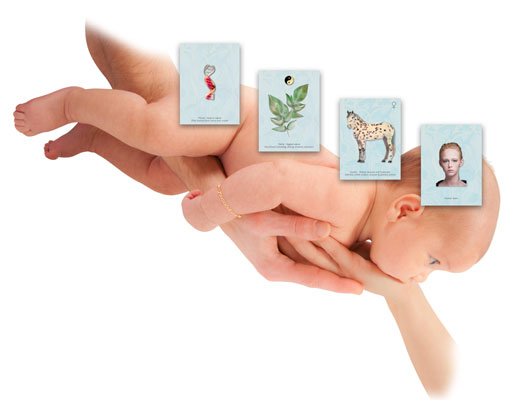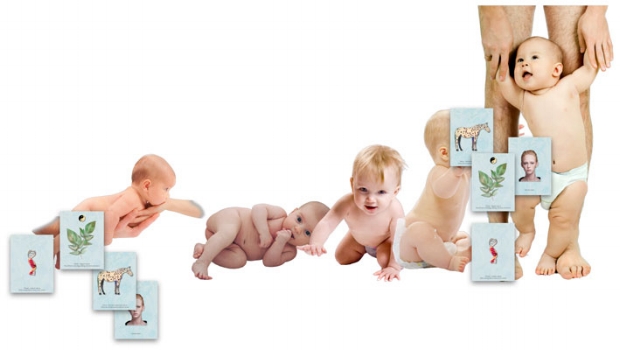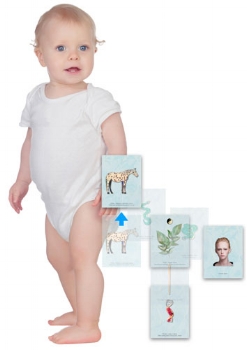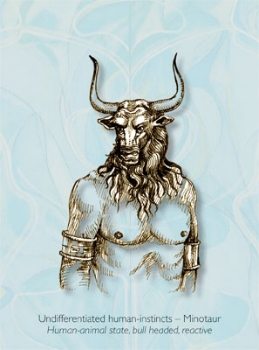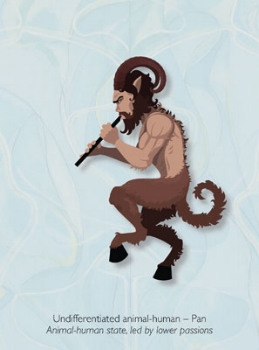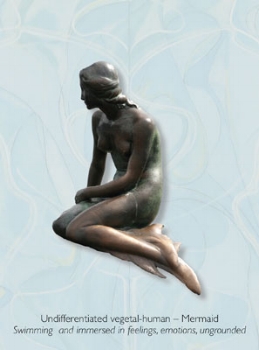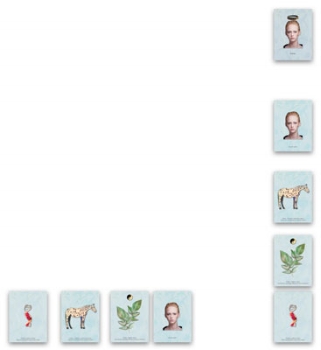From Horizontal to Vertical Life
When we emerge from the womb we are very vulnerable for the human organism is immature and helpless and depends completely on its mother. If the 40 weeks in utero was the development of embryo to fetus to infant, then the next few years illustrate the process yet again. In the first eight or nine months of life, the human child lacks the ability to be at any level, independent. If we were to look at this as part of a holon or holarchy then this child illustrates an undifferentiated state. It infers that the parts that have created it are not yet acting as interdependent holons or complete entities within the organism. The infant is functional– it lives–but it is not independent of its primary host, for although we are unattached from our uterine dependence on our mothers, we may still remain as if psychically attached to our mothers, and certainly for our immediate survival, we require constant attention. Graphically you could think of the child having a material self–a blueprint–a physiological self (systems and organs) with a partially developed mammalian self (gender, lungs, joints, and muscles; locomotive resource) and an incomplete human self (neocortex).
A newborn infant has all its natures intact, but some are more dominant than others; in the first few months, it has a dominant material nature (mass, gravity or weight, constitution), a very active physiological or vegetal nature (suckle, digest, excrete, sleep), a less than fully active instinctual component (unable to survive, stand, walk or be protective bar engaging with what’s around), a blank slate of a human mind or neocortex–which of course is receiving input at a phenomenal rate but will take more than several years to mature.
-
“The child looks like me (or his father)” – genetic or material self
-
“It is whole and complete–we counted the toes and fingers, he can hear, has startle reflexes, (scored 9 on the Apgar scale)– material integrity, “and cries, eats, poos and pees” – physiological or vegetal self),
-
“She does sleep and digest its food (flexibility), and she turns her head, hears my voice, looks at me (us), has four limbs, and wriggles around” – animal self (instincts) and reflectiveness (vision, seeing)
-
“and smiles and is beginning to respond (human-animal)”.
The infant is undifferentiated. It now goes through an intense period of cortical development, integration of its lower and higher centres becomes neurological competent (integrity) and begins to interact with the outside world, moves from wriggling its limbs to turning over, begins to crawl, stand and fall copying its peers and all that is going on around it. It is emergent.
From being helpless to being able to stand, the child finds integrity, and the capacity to stand upright, and in so doing starts the process of emergence.
As the child interacts with its environment, it begins to differentiate how it feels and starts to have different emotive-reactive responses to communicate its needs in its non-language period. Its voice is the cry, the whimper, the pout, the aggrieved, the wounded, the hurt as well as the giggle and laughter as it interacts with the mother and others. It differentiates too, through what it wants to eat, or not eat when it wants to go to bed, sleep, or be put down to rest or farmed out to the provider or nanny. It starts to emerge out of history and into an emotional world in which it begins to sift through ‘responses’ so that it can interact with its environment.
We send the child off to school, as it has outgrown its childhood environment, and is ready for another adventure, one of self-autonomy and discovery. This is the animal phase where the child now interacts with others, with different tribes and groups (if it’s lucky), and begins to discover self through others.
The Bantu word UBUNTU as described by Archbishop Desmond Tutu in 2008:
“One of the sayings in our country is Ubuntu – the essence of being human. Ubuntu speaks particularly about the fact that you can’t exist as a human being in isolation. It speaks about our interconnectedness. You can’t be human all by yourself, and when you have this quality – Ubuntu – you are known for your generosity.
We think of ourselves far too frequently as just individuals, separated from one another, whereas you are connected and what you do affects the whole world. When you do well, it spreads out; it is for the whole of humanity”
The development of this humanist or ethical model is our dynamic interaction with others. This is the training between instincts, desires, and needs, historical and unseen genes, and memes trying to promote their dominance or power over the organism. This phase can last a long time (“he’s never grown up, he’s always in survival mode, he’s always after the girls, she’s a little fox, out for what she can get”), and may last a lifetime. Generally speaking, we mark this movement from animal to human as another rite of passage. This is often the school matriculation or University graduation; where someone is honoured for their learning and erudition, which has paved their way towards being a meaningful and valuable contribution towards humanity.
Undifferentiated animal-human or human-animal
If we look at old mythologies and stories, we will note that often the old Greek myths (for example) were peppered with fantastical beasts; half-human half-animal, or an amalgam of several forms. These characterize levels of human development, very cleverly masking the idea that we are looking at rather intimate and personal images of our own natures when we are in this developing yet undifferentiated state. The undifferentiated state is our de facto situation; we are always developing from form to form, and in-between morphing with one realm into the other, so that the lower realm still has exaggerated influence over the realm above.
Minotaur – human-animal
The minotaur is a human with a bull-like head. The human and animal components are interchanged; as if the capacity to be reflective–the bridge between an instinctual reactive survival-based life and a cognitive reflective life–two human natures are juxtaposed. The human is unable to pause, and is always reactive, reflexive, and unpredictable; a bull in the china shop. There is no capacity for the person to fly, to be imaginative, to go beyond the known–as the animal instincts drive the organism.
Pan – the human-animal
We grow into a Pan, when our instinctual nature is still morphed and intimate with the human self it retains some of the characteristics of the goat. A satyr is simply the youthful aspect of this undifferentiated human. Pan’s life (flexibility) is in his rhythmical pan pipes made out of the reeds of a riverbed, and it is with these lilting melodic sounds he seduces all around him. The hedonist, bon vivant, the ladies man, the men and women (her animus) whose carnal and gourmet needs are met by this undifferentiated nature. Pan is a developing human, and yet it takes time to emerge out of this nature–we see it all around us when we observe how many people are caught having extramarital affairs, and have a dark side to their passions and needs.
Pan is a human who retains aspects of his instinctual behaviour in his human nature. The flute or pan pipes call out a merry tune and seduce the nymphs and women to his carnal desires, and appetites.
Mermaid – the Feeling-human
The mermaid represents the human who has not yet separated from their feelings, which although beneath their human nature–the tail–influences their humanity. These are people, rather idealistic, and often not grounded (they live in their feelings, and metaphorically are aquatic, and so do not live on terra firma) Indeed, if the stories are correct, they may even lose their voice when they do come on land. The width and breadth of their feeling nature are huge, so you will see these as people who are immersed in their feelings, and emotions. They support causes that depend on empathy and are in fact rather important in society because they carry the emotions and feelings of the planet. However, when they are unable to come on land, that is to differentiate or separate from their emotions– may never really accomplish their personal goals albeit may be the catalyst for others to finish the task.
The mermaid is the Feeling-human who lives in a sea of emotion, feelings, and empathy. They have not separated themselves from their vegetal or sensory nature.
There are numerous examples of undifferentiated humans, all of which tell the ancient story of our evolution as a human from our material original state to one that is a noble creature; from a one-storied house to a five-storied house or building. [NB This has no bearing at all, on our economic or social status but our inner state.]
Horizontal to vertical life; emergence from our material origins to a noble human life
All of us humans go through these stages, not necessarily any of those characterized above, but stages where our basic self has yet to separate and be able to operate in an autonomous way from that which lies below. The bridges of the caduceus –Integrity, Flexibility, reflectiveness, and Surender are the tools, resources, assets, qualities, and virtues that enable us to move and separate from the dominant and often lower self– allowing us to become whole or less undifferentiated. At all times, we are human. But we are in evolution, constantly developing only if we polish our interior Self. However, we are also often governed by our lesser or lower selves, but as we develop these elements within us, they become allies in our development.
